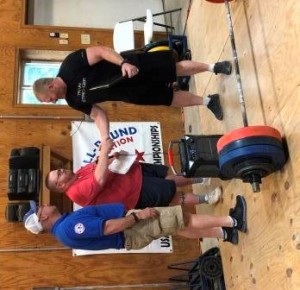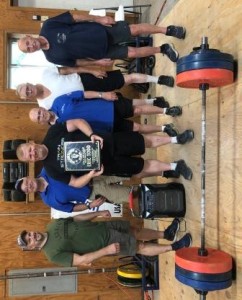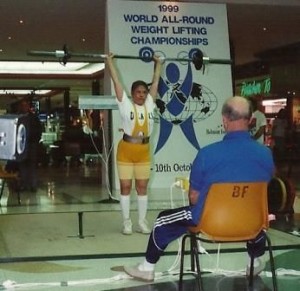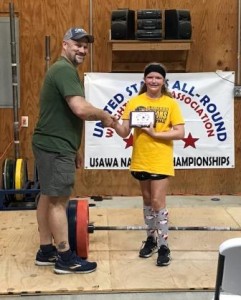By Al Myers

Eric Todd (right) receiving his Hall of Fame Award from Lance Foster (center) and Al Myers (left).
One of the big highlights of the USAWA Nationals weekend happened during the USAWA Awards Ceremony, in which Eric Todd was inducted into the USAWA Hall of Fame. It takes alot of time, effort, performance, and commitment to achieve this honor as the USAWA Hall of Fame is the highest award receivable in the USAWA. I was so happy to see Eric get recognized with this award as he has sure earned it! Eric (or ET as his friends know him) is the all round man in all round weightlifting. He does it all – competes, officiates, coaches, promotes, runs a club, and now serves as an officer in the USAWA.

Other USAWA Hall of Fame members present at the meet joined Eric in the presentation. (left to right): Chad Ullom, Al Myers, Eric Todd, Denny Habecker, LaVerne Myers, and Dean Ross
His friend and fellow KC Strongman club member Lance Foster gave an excellent Hall of Fame induction speech which I would like to share here. Lance has known and trained with Eric for many years, and was the perfect person to be part of this special moment.
Hall of Fame induction speech by Lance Foster
To quote the mission of the USAWA, (“The USAWA was formed to
continue the long standing tradition of old-time weightlifters like Eugen
Sandow, Louis Cyr, Arthur Saxon, Hermann Goerner, Warren
Lincoln Travis, and many others. We strive to preserve the history of the
original forms of weightlifting, which in the past has been referred to as
“odd lifting.” Many of the lifts we perform are based on stage
acts or challenge lifts of old-time strongmen”), exemplifies what Eric
Todd has brought, and continues to
bring, to the USAWA.
While he more than meets the point total to be considered for induction
into the Hall Of Fame by merit, I believe that nominating him on the
basis of honor is the better option. Eric has dedicated his life to
weightlifting and athletic pursuits. Eric began these pursuits pre-
Kindergarten, running behind his father
when he went jogging, to high school football, track, and wrestling. He
attended college on a wrestling scholarship, and achieved national
ranking, in addition to competing in Highland Games, Strongman, and
later all-round lifting. He has also coached wrestling on a formal basis in
the public school system. He has
also coached many people in Strongman on an informal basis, at his
personal gym, always being a true
friend, mentor, and coach, without fees of any type. He hosted an annual
Strongman contest for 10 years,
in honor his grandfather Gus (who, too, exemplified old time strongman
type strength and skill). While many Strongman promoters around the
country operate on a for profit basis, Eric selflessly donated all the
proceeds, totaling $34,000.00, to Camp Quality, a week long summer
camp for kids dealing with cancer.
Eric is an active participant and promoter in USAWA. He opens his gym
for the Postal meets, record days, as well as hosting the Old Time
Strongman Championships, and occasionally the Heavy Lifts
Championships. He is a lifetime certified official. He is a member of the
Century Club, having amassed 160 records. He was also named the
USAWA Athlete of the Year for 2018. While a fierce competitor, he
is always willing to assist other members with training and tips on lifts.
Eric is also dedicated to his family, not only by instilling in them the
skills to be kind and respectful, but also by being encouraging of his
children and a nephew, as they participate in all-round lifting, and fitness
in general.
Eric is a humble, down to earth man, never seeking the lime light for any
of his achievements. Eric is a man of high caliber, not only of physical
strength and prowess, but also by having the personality of a
stand-up individual.
For the reasons listed above, Eric Todd is hereby inducted into the
USAWA Hall of Fame.



